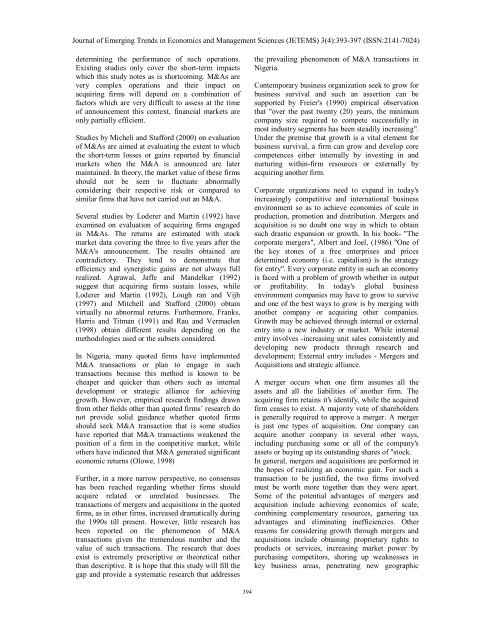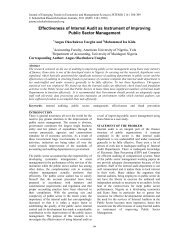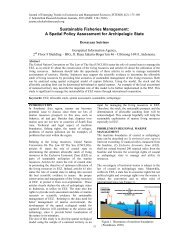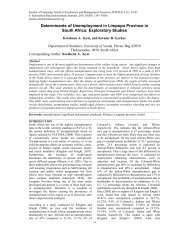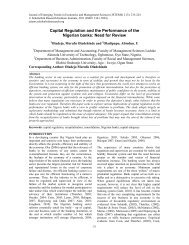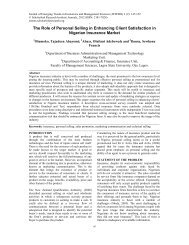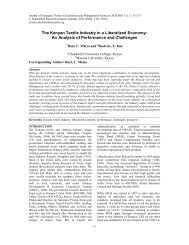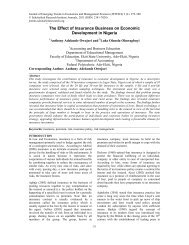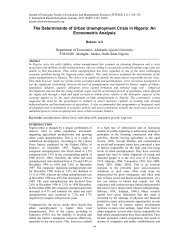Mergers and Performance of Conglomerates Companies in Nigeria
Mergers and Performance of Conglomerates Companies in Nigeria
Mergers and Performance of Conglomerates Companies in Nigeria
You also want an ePaper? Increase the reach of your titles
YUMPU automatically turns print PDFs into web optimized ePapers that Google loves.
Journal <strong>of</strong> Emerg<strong>in</strong>g Trends <strong>in</strong> Economics <strong>and</strong> Management Sciences (JETEMS) 3(4):393-397 (ISSN:2141-7024)<br />
determ<strong>in</strong><strong>in</strong>g the performance <strong>of</strong> such operations.<br />
Exist<strong>in</strong>g studies only cover the short-term impacts<br />
which this study notes as is shortcom<strong>in</strong>g. M&As are<br />
very complex operations <strong>and</strong> their impact on<br />
acquir<strong>in</strong>g firms will depend on a comb<strong>in</strong>ation <strong>of</strong><br />
factors which are very difficult to assess at the time<br />
<strong>of</strong> announcement this context, f<strong>in</strong>ancial markets are<br />
only partially efficient.<br />
Studies by Micheli <strong>and</strong> Stafford (2000) on evaluation<br />
<strong>of</strong> M&As are aimed at evaluat<strong>in</strong>g the extent to which<br />
the short-term losses or ga<strong>in</strong>s reported by f<strong>in</strong>ancial<br />
markets when the M&A is announced are later<br />
ma<strong>in</strong>ta<strong>in</strong>ed. In theory, the market value <strong>of</strong> these firms<br />
should not be seen to fluctuate abnormally<br />
consider<strong>in</strong>g their respective risk or compared to<br />
similar firms that have not carried out an M&A.<br />
Several studies by Loderer <strong>and</strong> Mart<strong>in</strong> (1992) have<br />
exam<strong>in</strong>ed on evaluation <strong>of</strong> acquir<strong>in</strong>g firms engaged<br />
<strong>in</strong> M&As. The returns are estimated with stock<br />
market data cover<strong>in</strong>g the three to five years after the<br />
M&A's announcement. The results obta<strong>in</strong>ed are<br />
contradictory. They tend to demonstrate that<br />
efficiency <strong>and</strong> synergistic ga<strong>in</strong>s are not always full<br />
realized. Agrawal, Jaffe <strong>and</strong> M<strong>and</strong>elker (1992)<br />
suggest that acquir<strong>in</strong>g firms susta<strong>in</strong> losses, while<br />
Loderer <strong>and</strong> Mart<strong>in</strong> (1992), Lough ran <strong>and</strong> Vijh<br />
(1997) <strong>and</strong> Mitchell <strong>and</strong> Stafford (2000) obta<strong>in</strong><br />
virtually no abnormal returns. Furthermore, Franks,<br />
Harris <strong>and</strong> Titman (1991) <strong>and</strong> Rau <strong>and</strong> Vermaelen<br />
(1998) obta<strong>in</strong> different results depend<strong>in</strong>g on the<br />
methodologies used or the subsets considered.<br />
In <strong>Nigeria</strong>, many quoted firms have implemented<br />
M&A transactions or plan to engage <strong>in</strong> such<br />
transactions because this method is known to be<br />
cheaper <strong>and</strong> quicker than others such as <strong>in</strong>ternal<br />
development or strategic alliance for achiev<strong>in</strong>g<br />
growth. However, empirical research f<strong>in</strong>d<strong>in</strong>gs drawn<br />
from other fields other than quoted firms’ research do<br />
not provide solid guidance whether quoted firms<br />
should seek M&A transaction that is some studies<br />
have reported that M&A transactions weakened the<br />
position <strong>of</strong> a firm <strong>in</strong> the competitive market, while<br />
others have <strong>in</strong>dicated that M&A generated significant<br />
economic returns (Olowe, 1998)<br />
Further, <strong>in</strong> a more narrow perspective, no consensus<br />
has been reached regard<strong>in</strong>g whether firms should<br />
acquire related or unrelated bus<strong>in</strong>esses. The<br />
transactions <strong>of</strong> mergers <strong>and</strong> acquisitions <strong>in</strong> the quoted<br />
firms, as <strong>in</strong> other firms, <strong>in</strong>creased dramatically dur<strong>in</strong>g<br />
the 1990s till present. However, little research has<br />
been reported on the phenomenon <strong>of</strong> M&A<br />
transactions given the tremendous number <strong>and</strong> the<br />
value <strong>of</strong> such transactions. The research that does<br />
exist is extremely prescriptive or theoretical rather<br />
than descriptive. It is hope that this study will fill the<br />
gap <strong>and</strong> provide a systematic research that addresses<br />
the prevail<strong>in</strong>g phenomenon <strong>of</strong> M&A transactions <strong>in</strong><br />
<strong>Nigeria</strong>.<br />
Contemporary bus<strong>in</strong>ess organization seek to grow for<br />
bus<strong>in</strong>ess survival <strong>and</strong> such an assertion can be<br />
supported by Freier's (1990) empirical observation<br />
that "over the past twenty (20) years, the m<strong>in</strong>imum<br />
company size required to compete successfully <strong>in</strong><br />
most <strong>in</strong>dustry segments has been steadily <strong>in</strong>creas<strong>in</strong>g".<br />
Under the premise that growth is a vital element for<br />
bus<strong>in</strong>ess survival, a firm can grow <strong>and</strong> develop core<br />
competences either <strong>in</strong>ternally by <strong>in</strong>vest<strong>in</strong>g <strong>in</strong> <strong>and</strong><br />
nurtur<strong>in</strong>g with<strong>in</strong>-firm resources or externally by<br />
acquir<strong>in</strong>g another firm.<br />
Corporate organizations need to exp<strong>and</strong> <strong>in</strong> today's<br />
<strong>in</strong>creas<strong>in</strong>gly competitive <strong>and</strong> <strong>in</strong>ternational bus<strong>in</strong>ess<br />
environment so as to achieve economies <strong>of</strong> scale <strong>in</strong><br />
production, promotion <strong>and</strong> distribution. <strong>Mergers</strong> <strong>and</strong><br />
acquisition is no doubt one way <strong>in</strong> which to obta<strong>in</strong><br />
such drastic expansion or growth. In his book- "The<br />
corporate mergers", Albert <strong>and</strong> Joel, (1986) "One <strong>of</strong><br />
the key stones <strong>of</strong> a free enterprises <strong>and</strong> prices<br />
determ<strong>in</strong>ed economy (i.e. capitalism) is the strategy<br />
for entry". Every corporate entity <strong>in</strong> such an economy<br />
is faced with a problem <strong>of</strong> growth whether <strong>in</strong> output<br />
or pr<strong>of</strong>itability. In today's global bus<strong>in</strong>ess<br />
environment companies may have to grow to survive<br />
<strong>and</strong> one <strong>of</strong> the best ways to grow is by merg<strong>in</strong>g with<br />
another company or acquir<strong>in</strong>g other companies.<br />
Growth may be achieved through <strong>in</strong>ternal or external<br />
entry <strong>in</strong>to a new <strong>in</strong>dustry or market. While <strong>in</strong>ternal<br />
entry <strong>in</strong>volves -<strong>in</strong>creas<strong>in</strong>g unit sales consistently <strong>and</strong><br />
develop<strong>in</strong>g new products through research <strong>and</strong><br />
development; External entry <strong>in</strong>cludes - <strong>Mergers</strong> <strong>and</strong><br />
Acquisitions <strong>and</strong> strategic alliance.<br />
A merger occurs when one firm assumes all the<br />
assets <strong>and</strong> all the liabilities <strong>of</strong> another firm. The<br />
acquir<strong>in</strong>g firm reta<strong>in</strong>s it's identify, while the acquired<br />
firm ceases to exist. A majority vote <strong>of</strong> shareholders<br />
is generally required to approve a merger. A merger<br />
is just one types <strong>of</strong> acquisition. One company can<br />
acquire another company <strong>in</strong> several other ways,<br />
<strong>in</strong>clud<strong>in</strong>g purchas<strong>in</strong>g some or all <strong>of</strong> the company's<br />
assets or buy<strong>in</strong>g up its outst<strong>and</strong><strong>in</strong>g shares <strong>of</strong> "stock.<br />
In general, mergers <strong>and</strong> acquisitions are performed <strong>in</strong><br />
the hopes <strong>of</strong> realiz<strong>in</strong>g an economic ga<strong>in</strong>. For such a<br />
transaction to be justified, the two firms <strong>in</strong>volved<br />
must be worth more together than they were apart.<br />
Some <strong>of</strong> the potential advantages <strong>of</strong> mergers <strong>and</strong><br />
acquisition <strong>in</strong>clude achiev<strong>in</strong>g economics <strong>of</strong> scale,<br />
comb<strong>in</strong><strong>in</strong>g complementary resources, garner<strong>in</strong>g tax<br />
advantages <strong>and</strong> elim<strong>in</strong>at<strong>in</strong>g <strong>in</strong>efficiencies. Other<br />
reasons for consider<strong>in</strong>g growth through mergers <strong>and</strong><br />
acquisitions <strong>in</strong>clude obta<strong>in</strong><strong>in</strong>g proprietary rights to<br />
products or services, <strong>in</strong>creas<strong>in</strong>g market power by<br />
purchas<strong>in</strong>g competitors, shor<strong>in</strong>g up weaknesses <strong>in</strong><br />
key bus<strong>in</strong>ess areas, penetrat<strong>in</strong>g new geographic<br />
394


